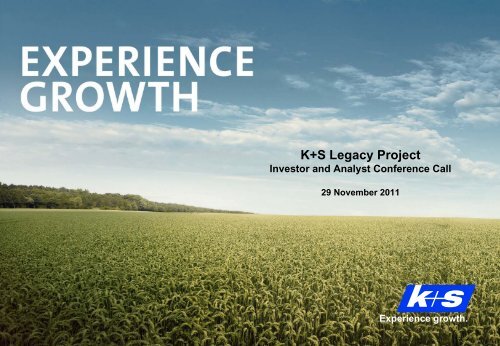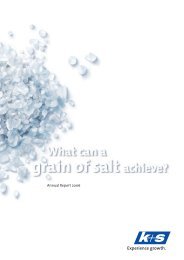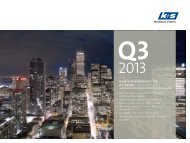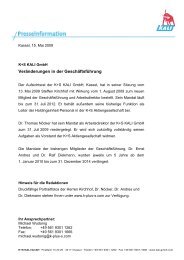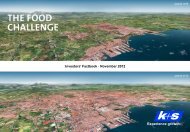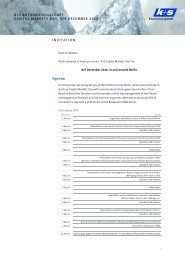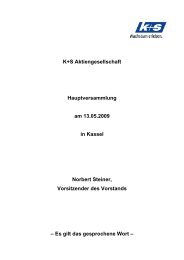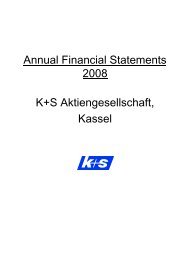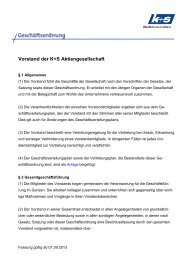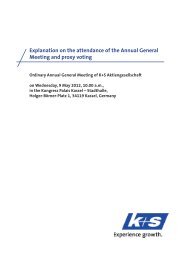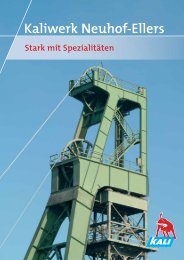Statement - K+S Aktiengesellschaft
Statement - K+S Aktiengesellschaft
Statement - K+S Aktiengesellschaft
Create successful ePaper yourself
Turn your PDF publications into a flip-book with our unique Google optimized e-Paper software.
<strong>K+S</strong> Legacy Project<br />
Investor and Analyst Conference Call<br />
29 November 2011<br />
Experience growth.<br />
November 2011<br />
<strong>K+S</strong> Group
<strong>K+S</strong> Group<br />
Content<br />
A. Acquisition of Potash One<br />
B. Legacy Project – Overview<br />
C. Technical Concept<br />
D. Market and Logistics<br />
E. Financing<br />
F. Conclusion<br />
November 2011<br />
<strong>K+S</strong> Group<br />
1
<strong>K+S</strong> Group<br />
Potash One and the Legacy Project<br />
• With Potash One, <strong>K+S</strong> has acquired<br />
several potash exploration permits in<br />
Saskatchewan/Canada (incl. the<br />
Legacy Project and its feasibility<br />
study).<br />
Southern area of the potash belt of Saskatchewan<br />
Located in the Heart of (Schematic Saskatchewan’s Diagram) Potash-Rich Basin<br />
• The total purchase price was<br />
€ 322.5 million (CAD 4.50 per share).<br />
• The Legacy Project is an advanced<br />
greenfield project for which an<br />
environmental permit has been granted.<br />
• Potash One is now fully incorporated<br />
in <strong>K+S</strong> Potash Canada GP.<br />
Regina<br />
Two more potash exploration licences close to Esterhazy<br />
Two additional potash permit areas in the Esterhazy potash region<br />
Reserves and Resources<br />
in mln. t KCl % KCl % K 2<br />
O<br />
Reserves (Proven and Probable Reserves) Legacy Project area 160 29 18<br />
Resources (Inferred and Indicated Resources) Legacy Project area + KLSA 009 982 27 17<br />
The reserves figures were determined by Agapito Associates Inc., Grand Junction, Colorado, in cooperation with North Rim Exploration Ltd., Saskatoon,<br />
Saskatchewan. The report on their determination was created in accordance with the requirements of the Canadian standard Nl 43-101 of the “Canadian Securities Regulators”.<br />
November 2011<br />
<strong>K+S</strong> Group<br />
2
<strong>K+S</strong> Group<br />
Potash One – A Perfect Strategic Fit<br />
Growth<br />
Production Costs<br />
Capacity and<br />
Mine Life<br />
Regional Mix<br />
Specialisation<br />
Flexibility /<br />
Expansion Potential<br />
• Adding substantial new capacities to the Potash and Magnesium business<br />
segment in a relatively short timeframe to be able to participate in the growth<br />
of the world potash market<br />
• The addition of a solution mining production facility will have a positive effect on<br />
average production costs and increase flexibility<br />
• Substantial addition of annual capacity<br />
• Substantial extension of average mine life<br />
• Diversification of the regional portfolio via a higher exposure to North America and<br />
the emerging markets in South America and Asia<br />
• Continuation of the specialisation strategy by offering high-quality industrial grade<br />
products from Canada<br />
• Good scalability of production capacity according to market development<br />
• Improved flexibility due to higher share of variable costs<br />
• Further expansion potential beyond the Legacy Project<br />
November 2011<br />
The Potash One acquisition fits perfectly with the <strong>K+S</strong> strategy of capturing<br />
the growth of the global potash market and maintaining a market share of<br />
more than 10% at an improved competitiveness<br />
<strong>K+S</strong> Group<br />
3
<strong>K+S</strong> Group<br />
Content<br />
A. Acquisition of Potash One<br />
B. Legacy Project – Overview<br />
C. Technical Concept<br />
D. Market and Logistics<br />
E. Financing<br />
F. Conclusion<br />
November 2011<br />
<strong>K+S</strong> Group<br />
4
<strong>K+S</strong> Group<br />
Ramp-up Curve<br />
Production capacity<br />
in mln. t KCl/a<br />
4.0<br />
3.5<br />
3.0<br />
2.5<br />
2.0<br />
1.5<br />
1.0<br />
0.5<br />
0.0<br />
Phase 2 – Development of secondary mining<br />
Phase 1 – Primary mining<br />
Outlook for Phase 3 –<br />
Expansion of secondary mining<br />
2011'12 '13 '14 '15 '16 '17 '18 '19 '20 '21 '22 '23 '24 '25 '26 '27 '28 '29 '30 '31 '32 '33 '34 '35<br />
1.14<br />
0.86<br />
2.00<br />
Phase 1<br />
(Implementation: 2011 to 2017)<br />
Phase 2<br />
(Implementation: 2016 to 2023)<br />
Outlook for Phase 3<br />
(Implementation: 2023 to 2034)<br />
● Development of infrastructure mainly for Phases 1 + 2, preparations for Phase 3<br />
● Capacity development + ramp-up of production to 2.0 mln. t KCl/a through primary mining<br />
● Capacity expansion and ramp-up of production by 0.86 to 2.86 mln. t KCl/a<br />
through secondary mining (share of secondary mining in total capacity: 30%)<br />
● Increase in share of secondary mining in total capacity to 50%<br />
● Potential expansion of annual capacity by 1.14 to 4.0 mln. t KCl/a<br />
November 2011<br />
<strong>K+S</strong> Group<br />
5
<strong>K+S</strong> Group<br />
Course of Capex<br />
Phase 1<br />
Phase 2<br />
Phase 3<br />
Activity<br />
Primary mining: Development of<br />
first caverns and construction<br />
of production and<br />
infrastructure facilities<br />
Development of secondary mining,<br />
expansion of production and<br />
logistics facilities<br />
Further expansion of secondary<br />
mining, construction of necessary<br />
additional production and logistics<br />
facilities<br />
Production<br />
capacity after<br />
implementation<br />
as of 2017:<br />
2.00 million tonnes KCl/a<br />
as of 2023:<br />
2.86 million tonnes KCl/a<br />
probably as of 2034:<br />
4.00 million tonnes KCl/a<br />
Capex 2011 to 2016: CAD 2.90 billion* 2016 to 2022: CAD 0.35 billion* 2023 to 2034: ~ CAD 0.70 billion<br />
Diagram of<br />
course of<br />
investment<br />
2011 2012 2013 2014 2015 2016 2016 2017 2018 2019 2020 2021 2022<br />
November 2011<br />
* Approved by the Supervisory Board<br />
<strong>K+S</strong> Group<br />
6
<strong>K+S</strong> Group<br />
3-Phase Concept with Positive Economies<br />
of Scale<br />
Specific capex<br />
(in CAD billion per million tonnes KCl/a)<br />
1.6<br />
1.5<br />
1.4<br />
1.2<br />
1.1<br />
1.0<br />
0.8<br />
0.6<br />
0.4<br />
1.0<br />
Increasing capacity results in positive<br />
economies of scale<br />
Including Phase 3, a favourable ratio<br />
of CAD 1 billion of capex per<br />
1 million tonnes KCl/a is possible<br />
0.2<br />
0.0<br />
Phase 1 Phase 1 + 2 Phase 1 + 2 + 3<br />
November 2011<br />
<strong>K+S</strong> Group<br />
7
<strong>K+S</strong> Group<br />
Composition of Capex for Phases 1 + 2<br />
Capex in Phases 1 + 2<br />
(in CAD billion)<br />
Direct capex in solution mining, process plant, infrastructure 1.85<br />
Engineering, indirect construction costs, other 0.65<br />
Contingency / Escalation<br />
Indirect capex<br />
0.40<br />
Total direct and indirect capex for Phase 1 2.90<br />
Direct expansion capex for solution mining and factory 0.30<br />
Indirect expansion capex 0.05<br />
Total direct and indirect capex for Phase 2 0.35<br />
Total capex for Phases 1 + 2 3.25<br />
November 2011<br />
<strong>K+S</strong> Group<br />
8
<strong>K+S</strong> Group<br />
Capex: Potash One Feasibility Study vs. <strong>K+S</strong>-Review<br />
USD billion<br />
3.5<br />
CAD billion<br />
3.5<br />
3.25<br />
3.0<br />
3.0<br />
2.90*<br />
0.10<br />
0.25 Phase 2<br />
(0.86 mln. t)<br />
2.70<br />
Phase 2<br />
(0.86 mln. t)<br />
2.5<br />
Phase 2<br />
(0.86 mln. t)<br />
Phase 1<br />
(2 mln. t)<br />
2.5<br />
Phase 1<br />
(2 mln. t)<br />
Phase 1<br />
(2 mln. t)<br />
2.0<br />
Potash One (USD)<br />
2.0<br />
Potash One (CAD)<br />
Higher direct and indirect<br />
capex<br />
Upgrade: Granulation +<br />
industrial potash<br />
<strong>K+S</strong> Legacy<br />
<br />
<br />
The capex expected for Phases 1 + 2 are in total about CAD 350 million higher than what is stated in<br />
the feasibility study of Potash One<br />
This is primarily attributable to an optimisation of the product mix (facilities for the production of<br />
granulated potassium chloride and industrial potash)<br />
* Conversion of USD into CAD at the exchange rate valid at the time of publication of the feasibility study: 1.07 CAD/USD<br />
November 2011<br />
<strong>K+S</strong> Group<br />
9
<strong>K+S</strong> Group<br />
Specific Cash Costs*<br />
CAD/tonne<br />
175<br />
150<br />
125<br />
100<br />
75<br />
50<br />
25<br />
~ 165 CAD/tonne<br />
Average<br />
logistic<br />
costs<br />
Cash costs of<br />
production:<br />
~ 95 CAD/tonne<br />
● The cash costs of production will be lower for<br />
Legacy than in our plants in Germany<br />
● The high share of variable cost components<br />
(incl. freight) makes possible greater flexibility in<br />
relation to capacity utilisation:<br />
Legacy: 2/3 variable; 1/3 fixed<br />
Germany: 1/3 variable; 2/3 fixed<br />
● For mining taxes/royalties, an additional approx.<br />
CAD 70/tonne are to be recognised on the basis<br />
of a potash price of US$ 450/tonne ex works<br />
● Over the long term, depreciation and<br />
amortisation will total about CAD 30/tonne after<br />
initially higher values at the start of production<br />
0<br />
* At full utilisation of 2.86 million tonnes KCl/a (Phases 1+2)<br />
Assumptions: gas price: CAD 4.30/MMBtu; exchange rate: 1.02 CAD/USD; no increase in prices and costs after the construction phase<br />
November 2011<br />
<strong>K+S</strong> Group<br />
10
<strong>K+S</strong> Group<br />
What Potash Price is Required as a Minimum for the<br />
Profitability of the Legacy Project?<br />
The Legacy Project requires a potash price of between USD 400 and 450/tonne MOP<br />
gran. including freight in order to achieve a return on capital employed (ROCE) of<br />
12% before taxes<br />
Parameters like the level of investment, gas price or freight rates could move respectively as follows, without<br />
jeopardising the planned target return or the range mentioned above:<br />
Parameter Basis Tolerance<br />
Capex (Phases 1 + 2) CAD 3.25 billion ± 15%<br />
Gas price (Henry Hub Natural Gas Price) CAD 4.30/MMBtu ± 50%<br />
Average freight rates ~ CAD 70/tonne ± 30%<br />
The Legacy Project is one of the world’s economically most attractive greenfield<br />
projects. The relatively favourable minimum price for this project cannot simply be<br />
transferred to other greenfield projects; higher minimum prices are to be expected.<br />
November 2011<br />
<strong>K+S</strong> Group<br />
11
<strong>K+S</strong> Group<br />
Content<br />
A. Acquisition of Potash One<br />
B. Legacy Project – Overview<br />
C. Technical Concept<br />
D. Market and Logistics<br />
E. Financing<br />
F. Conclusion<br />
November 2011<br />
<strong>K+S</strong> Group<br />
12
<strong>K+S</strong> Group<br />
Geological Overview<br />
Legacy Project<br />
Patience Lake<br />
Belle Plaine<br />
Esterhazy<br />
Mining technique<br />
Reserves / Resources<br />
Depth<br />
Thickness<br />
K 2<br />
O / KCl content<br />
Environmental<br />
Impact <strong>Statement</strong><br />
Solution mining<br />
160 / 982 mln. t KCl product<br />
1,500 metres<br />
33 metres<br />
18% / 29%<br />
approved for up to<br />
4 mln. t KCl/a<br />
November 2011<br />
<strong>K+S</strong> Group<br />
13
<strong>K+S</strong> Group<br />
Schematic Site Overview<br />
Tailings + crystallisation pond<br />
Process plant<br />
Well field<br />
• Per cavern, there are two 1,600 m<br />
deep, deflected boreholes about<br />
80 m apart<br />
• The layout provides for 18 bores<br />
from a central drilling site, known<br />
as a pad. Nine caverns are<br />
developed from these 18 bores<br />
• The solution is pumped through<br />
pipelines from the well field into<br />
the process plant for processing<br />
• The solid process by-product<br />
(NaCl) is stored in the tailings<br />
management area (TMA)<br />
• KCI crystallisation takes place<br />
from the secondary mining solution<br />
in the crystallisation pond<br />
November 2011<br />
<strong>K+S</strong> Group<br />
14
<strong>K+S</strong> Group<br />
Primary and Secondary Mining<br />
Patience Lake Seam<br />
Belle Plaine Seam<br />
Esterhazy Seam<br />
Primary Mining (Freshwater mining / Vacuum cooling crystallisation)<br />
• Primary mining uses freshwater. The connection of two boreholes to a<br />
cavern with the corresponding creation of a surface is initially created by NaCl<br />
solution mining below the KCl-rich Esterhazy Seam. The deposit is gradually<br />
solution-mined in up to 3 m thick horizontal layers through the three potash<br />
seams. This process is controlled vertically by an oil barrier (a thin layer on the<br />
surface of the brine).<br />
• During the primary mining process, the cavern expands to create an<br />
ideal form for commencing secondary mining.<br />
Secondary Mining (NaCl brine mining / Crystallisation in the crystallisation pond)<br />
• Secondary mining exclusively uses a NaCl-saturated brine in order to<br />
dissolve selectively KCl from the walls and roof of the existing caverns.<br />
• Along with a lower energy intensity, secondary mining – in comparison to<br />
primary mining – is substantially more efficient with the use of water.<br />
November 2011<br />
<strong>K+S</strong> Group<br />
15
<strong>K+S</strong> Group<br />
Diagram of the Process Plant<br />
Site run-off pond<br />
Administration<br />
building<br />
Compacting plants<br />
(red / white)<br />
Debrining/<br />
drying<br />
Crystallisation<br />
facility<br />
Well field<br />
Product storage<br />
Evaporation<br />
facility<br />
Loading stations<br />
Rail<br />
system<br />
Product storage<br />
Injection<br />
wells<br />
Process water<br />
pond<br />
Pipeline to<br />
well field<br />
November 2011<br />
<strong>K+S</strong> Group<br />
16
<strong>K+S</strong> Group<br />
Energy Concept<br />
The energy concept provides for the external procurement of natural gas and power<br />
• The energy-intensive processing facilities were laid out with regard to an optimal relationship between heat<br />
and power consumption<br />
• Natural gas will be used as the primary energy carrier, power will be obtained from the public grid<br />
• As regards the procurement of natural gas, fixed prices can be secured for up to 24 months in advance via<br />
tranches. The use of financial instruments to hedge against higher natural gas prices will be examined at the<br />
appropriate time as part of our general hedging strategy<br />
• As regards the procurement of natural gas, there are a number of suppliers we can use. Talks are already<br />
underway<br />
November 2011<br />
<strong>K+S</strong> Group<br />
17
<strong>K+S</strong> Group<br />
Water Supply<br />
Fresh water supply:<br />
• Water is supplied from the nearby Buffalo<br />
Pound Lake via a lakeside pumping station and<br />
pipelines into a reservoir on the plant site from<br />
which the water can be used as needed<br />
Benefits of solution/secondary mining:<br />
• In the case of solution mining, in comparison to<br />
conventional mining, a better utilisation of the<br />
deposit is achieved, as almost the entire thickness<br />
(33 m average thickness versus about 4 m in a<br />
conventional mine) can be mined and insoluble<br />
elements remain underground<br />
• Overall, there is less solid above-ground residue with solution mining<br />
• Since, with secondary mining, potash can be mined by means of natural, climate-related cooling<br />
crystallisation without evaporation of the solution, water consumption is lower compared to that with<br />
primary mining and conventional mining<br />
November 2011<br />
<strong>K+S</strong> Group<br />
18
<strong>K+S</strong> Group<br />
Injection of Saline Waters<br />
Advantages<br />
• ecologically reasonable and<br />
accepted practice in Canada<br />
• injection horizon permanently absorptive<br />
• farsighted approval process<br />
Potash<br />
seams<br />
Rock salt<br />
Rock salt<br />
Injection horizon<br />
November 2011 <strong>K+S</strong> Group 19
<strong>K+S</strong> Group<br />
Environmental Permits<br />
Environmental Impact <strong>Statement</strong> (EIS)<br />
• The environmental impact statement was approved in November 2010<br />
• The conditions of the approval are comparable with those of other competitors<br />
• All work in accordance with approved environmental impact statement and existing licensing requirements<br />
• The appropriate minister must be informed in the event of material changes<br />
• Cooperation with the industry or individually, search for alternatives for:<br />
- Storage of residue<br />
- Reduction in water consumption<br />
- Impact of mining subsidence<br />
As the process has proceeded and is proceeding, approval processes for subprojects<br />
(operational plans, e.g. for drilling) have been and are being initiated<br />
Thus far, all necessary approvals have been granted in time!<br />
November 2011<br />
<strong>K+S</strong> Group<br />
20
<strong>K+S</strong> Group<br />
Development of Workforce until 2020<br />
FTE<br />
350<br />
300<br />
250<br />
200<br />
150<br />
100<br />
50<br />
0<br />
2012 2013 2014 2015 2016 2017 2018 2019 2020<br />
• 2011: First employees hired, in particular with qualifications in solution mining<br />
• The number of operations employees will increase until 2017/18 in line with the ramp-up curve of the plant to<br />
just over 300 employees, incl. plant management, brine field, technology and production, maintenance and<br />
plant administration<br />
• Additionally, contract workers (mostly in the well field and maintenance) will support the operations<br />
• Construction workforce will peak at over 1,000 workers on site<br />
November 2011<br />
<strong>K+S</strong> Group<br />
21
<strong>K+S</strong> Group<br />
Content<br />
A. Acquisition of Potash One<br />
B. Legacy Project – Overview<br />
C. Technical Concept<br />
D. Market and Logistics<br />
E. Financing<br />
F. Conclusion<br />
November 2011<br />
<strong>K+S</strong> Group<br />
22
<strong>K+S</strong> Group<br />
Expansion of Global Presence of <strong>K+S</strong><br />
Strengthen global presence!<br />
• Expansion of our existing production network by a North<br />
American production site Potash supplier with<br />
production on two continents<br />
China<br />
India<br />
South East Asia<br />
North America<br />
• Increasing diversification of the country portfolio of the<br />
<strong>K+S</strong> Group:<br />
- North and South America<br />
- China, India and South East Asia<br />
South America<br />
• Sale and distribution via existing distribution structures of<br />
the <strong>K+S</strong> Group<br />
• Flexible multi-product strategy:<br />
- MOP standard pink<br />
- MOP granulated pink<br />
- KCl 99 granulated<br />
November 2011<br />
<strong>K+S</strong> Group<br />
23
<strong>K+S</strong> Group<br />
Good Logistical Connections<br />
Longview<br />
Portland<br />
• Main transport route to the ports of Vancouver, Longview or Portland (2,000 kilometres) by rail<br />
• At a production capacity of 2.86 million tonnes, about 1,000 railcars of 100 tonnes each or 6 trains<br />
are needed. A train with 170 railcars makes a 10-day return journey<br />
• Negotations for the provision of port storage capacity and loading facilities are in progress<br />
November 2011<br />
<strong>K+S</strong> Group<br />
24
<strong>K+S</strong> Group<br />
Legacy Project of Strategic Importance<br />
• Continuation of <strong>K+S</strong> growth strategy, which provides for the expansion of the potash capacities<br />
and the extension of the average useful lives of our mines<br />
• Strengthening the international competitiveness of the <strong>K+S</strong> Group in Europe and overseas<br />
Strategic goals of the Potash and<br />
Magnesium Products business segment<br />
Further development of refining strategy<br />
Consolidating our position for standard products<br />
Accessing attractive sales potentials<br />
Increasing flexibility<br />
Optimising costs<br />
November 2011<br />
Contribution of the Legacy Project<br />
Industrial quality (KCL 99) from solution mining<br />
Strengthening of volume basis for MOP gran/std.<br />
Good logistics position for growth markets<br />
Solution mining permits flexible adjustment to demand<br />
Sustainably lower production costs<br />
<strong>K+S</strong> Group<br />
25
<strong>K+S</strong> Group<br />
Content<br />
A. Acquisition of Potash One<br />
B. Legacy Project – Overview<br />
C. Technical Concept<br />
D. Market and Logistics<br />
E. Financing<br />
F. Conclusion<br />
November 2011<br />
<strong>K+S</strong> Group<br />
26
<strong>K+S</strong> Group<br />
Indicative Earnings Development<br />
Legacy Project Phases 1 + 2<br />
Turnaround already in<br />
2016/2017 with the<br />
achievement of full ramp-up of<br />
phase 1 (2 mln. t KCl/a)<br />
EBITDA<br />
EBIT<br />
2011 2012 2013 2014 2015 2016 2017 2018 2019 2020 2021 2022 2023 2024 2025<br />
EBIT in 2015 expected to be<br />
burdened due to first<br />
depreciation charges<br />
November 2011<br />
<strong>K+S</strong> Group<br />
27
<strong>K+S</strong> Group<br />
Exchange Rate Management<br />
Capex phase<br />
• Investments in USD (smaller part):<br />
Integration into USD long net position of Potash and Magnesium Products business segment,<br />
natural cash flow hedge leads to a reduction in the necessary hedging volume<br />
(general exchange rate hedging strategy: revolving one to two years in advance through the use of<br />
options and/or futures)<br />
• Investments in CAD (majority):<br />
Partly natural cash flow hedge through surpluses of salt business in Canada, remaining CAD short net<br />
position is hedged in accordance with general exchange rate hedging strategy<br />
Operational phase<br />
• The arising currency positions (revenues, costs, earnings, capex in CAD and/or USD)<br />
are hedged in accordance with general exchange rate hedging strategy<br />
While our net position in CAD will be short especially in the construction phase, but also<br />
thereafter, our USD long net position will increase significantly as of 2017.<br />
November 2011<br />
<strong>K+S</strong> Group<br />
28
<strong>K+S</strong> Group<br />
Financing of the Legacy Project<br />
• <strong>K+S</strong>, with a level of indebtedness (including provisions for pensions and mining obligations) of currently less<br />
than 25%, has a very solid balance sheet structure. The net financial liabilities are only about € 60 million<br />
(as at 30 September 2011)<br />
• The financing of the Legacy Project is possible predominantly from liquidity and future cash flows. Refinancing<br />
of the bond maturing in 2014 is assumed. From today’s perspective, we therefore expect an extension of<br />
borrowing, before positive cash flows are used for its repayment<br />
• <strong>K+S</strong> intends to maintain its existing, essentially earnings-based dividend policy with a dividend payout ratio of<br />
about 40 to 50% of adjusted Group earnings after taxes<br />
• Moreover, we are striving to retain our „Investment Grade“ rating<br />
Thanks to our strong balance sheet, ongoing cash flow generation and positive paybacks<br />
from the project, the financing is standing on a solid basis<br />
November 2011<br />
<strong>K+S</strong> Group<br />
29
<strong>K+S</strong> Group<br />
Content<br />
A. Acquisition of Potash One<br />
B. Legacy Project – Overview<br />
C. Technical Concept<br />
D. Market und Logistics<br />
E. Financing<br />
F. Conclusion<br />
November 2011<br />
<strong>K+S</strong> Group<br />
30
<strong>K+S</strong> Group<br />
The Legacy Project – New State-of-the-art Potash<br />
Capacities<br />
• The acquisition of Potash One was an important milestone for <strong>K+S</strong>, creating the basis for an improvement in<br />
the competitive position and offering growth potential for the coming decades<br />
• The Legacy Project enables us to ramp up production up to 4 million tonnes KCl/a at an attractive ratio of<br />
CAD 1 billion for 1 million tonnes KCl/a<br />
• Average cash costs of the Legacy Project will improve overall cost position and flexibility of the Potash and<br />
Magnesium Products business segment<br />
• With a potash price of between USD 400 and 450/tonne MOP gran. including freight, the project achieves a<br />
ROCE of 12% and an attractive premium on our costs of capital (9.6% before taxes). The Legacy Project is<br />
thus one of the world’s economically most attractive greenfield projects<br />
• Environmental Impact <strong>Statement</strong> approved<br />
• <strong>K+S</strong> will be a potash producer with the widest product portfolio as well as one of the most diversified<br />
production networks and regional mix<br />
• Financing of the project on a solid basis due to our strong balance sheet, ongoing cash flow generation and<br />
positive paybacks from the project itself<br />
November 2011<br />
<strong>K+S</strong> Group<br />
31
<strong>K+S</strong> Group<br />
Forward-Looking <strong>Statement</strong>s<br />
This presentation contains facts and forecasts that relate to the future development of the <strong>K+S</strong><br />
Group and its companies. The forecasts are estimates that we have made on the basis of all the<br />
information available to us at this moment in time. Should the assumptions underlying these forecasts<br />
prove not to be correct or should certain risks – such as those referred to in the recent Risk<br />
Report – materialise, actual developments and events may deviate from current expectations. The<br />
Company assumes no obligation to update the statements contained in this presentation, save for<br />
the making of such disclosures as are required by the provisions of statute.<br />
November 2011<br />
<strong>K+S</strong> <strong>K+S</strong> Group Group
<strong>K+S</strong> <strong>Aktiengesellschaft</strong><br />
Bertha-von-Suttner-Strasse 7<br />
34131 Kassel | Germany<br />
phone: +49 (0)561 / 9301-0<br />
fax: +49 (0)561 / 9301-1753<br />
Investor Relations<br />
phone: +49 (0)561 / 9301-1100<br />
fax: +49 (0)561 / 9301-2425<br />
email: investor-relations@k-plus-s.com<br />
Internet: www.k-plus-s.com<br />
Experience growth.<br />
November 2011<br />
<strong>K+S</strong> Group


